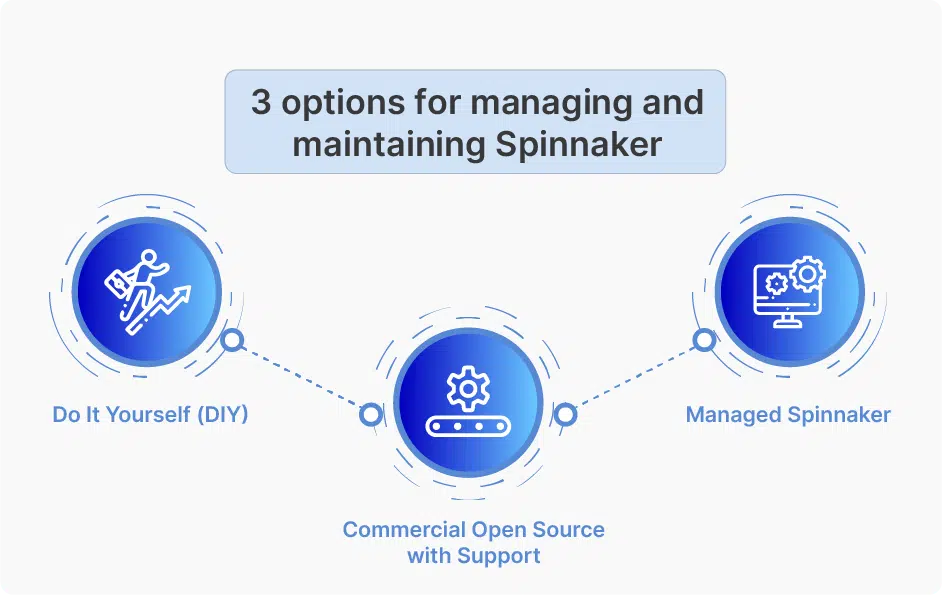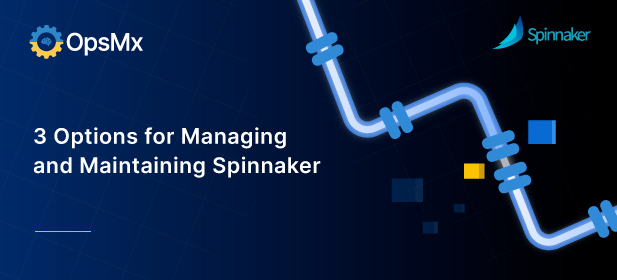Open source software is mainstream. Most businesses today have either already adopted open-source software or are thinking to adopt one. In fact, a survey found that “89% of businesses run open-source software internally, while 65% contribute to open-source software projects.“
Spinnaker is a widely deployed open-source Continuous Delivery (CD) platform adopted by thousands of enterprises. It was designed specifically for the cloud. Many organizations use Spinnaker to transform their Continuous Delivery practice because it is open-source, easily integrates with the CI/CD toolchain, and supports safe multi-cloud and Kubernetes deployments out of the box.
However, Spinnaker requires training and support to get started. Furthermore, like any software, the cost, time, and resources to manage and maintain the performance and availability of the Spinnaker service and infrastructure rise exponentially as you scale out your CD practice.
Considering these reasons, it is imperative that businesses weigh the pros and cons of open source software before venturing into it.
3 Options for Managing and Maintaining Spinnaker

Do It Yourself (DIY)
This approach may not be suitable for organizations of every scale. Large-scale organizations that have the top engineering talent, vast resources, culture, and expertise can adopt a 100% DIY approach. Plus, maintaining a customized OSS comes with certain business risks, incur higher costs, and is often prone to production failures. However, if done right, a 100% DIY approach can provide immense flexibility and total control.
Commercial Open Source with Support
The second operating model for maintaining open source software is to partner with a Commercial Open Source vendor. This model makes sense for the organizations that need to start deploying mission-critical applications from Day One but are unable to do so due to a lack of expertise. These vendors typically help enterprises who need help with deploying the software at speed and reduced costs. They are an excellent option when enterprises want to deploy for mission-critical and production environments. The vendor is responsible for any updates, fixes, and faster issue response and resolution. In other words, Commercial Open Source vendors can aid developer productivity by helping them focus on more valuable tasks instead of troubleshooting. Despite all the benefits, Commercial Open Source comes with a few flaws such as vendor lock-in and higher subscription costs.
Managed Spinnaker
Open source setup, configuration, maintenance, and support can often be taxing for small-scale organizations. That is why a managed Spinnaker or Spinnaker-as-a-Service makes a great choice for them as they lack the expertise to manage a Spinnaker installation. Typically, the Spinnaker installation is deployed to either on-premise or public cloud infrastructure.
Advantages of a Spinnaker-as-a-Service option
Spinnaker-as-a-service or SaaS model enables enterprises with all the support they need to succeed. Typically, it offers Spinnaker lifecycle management, helps enforce audit and compliance, enables seamless adoption of enterprise-scale adoption, automates risk assessment, and provides mission-critical support among many others. Some of the top benefits include:
Reduces business risks
With the SaaS model, it is extremely easy for customers to onboard Spinnaker and hence this model improves user adoption. By using machine learning to provide risk assessment during all stages of production, this model provides improved security and reduces production failures. SaaS can enable organizations to avoid compliance violations by templatizing compliance and policy.
Lowers costs
Enterprises can easily save the costs related to manual release verification with this model. Not having to spend on maintaining custom features and custom integrations, enterprises eliminate spending on ongoing costs.
Increases developer and organizational productivity
A SaaS model automates critical tasks for developers and boosts their productivity with AI/ML. This, in turn, helps them to focus on fixing bugs and releasing with velocity. As a result, the chances of errors and failures are reduced, enabling teams to release better software.
Reduces risk
Almost all vendors nowadays provide 24X7 mission-critical support that helps to mitigate the risks. This also ensures reduced misconfiguration errors and lowers downtime.
Conclusion
Every enterprise is different and has different needs and capabilities. For some, a DIY operating model may work just fine, but for others commercial open source with support or managed Spinnaker can be the most viable option. Whatever the use case is, OpsMx has a solution for businesses of all sizes. It enables organizations to begin their Spinnaker journey and achieve Continuous Delivery in just 30 days.
If you would like to learn more about the differences between a managed service and a SaaS offering or you are thinking about the things to consider when migrating to a Spinnaker-as-a-Service option, be sure to join us on Jul 27 2022 in an upcoming webinar. In this live session, our experts will discuss the pros and cons of subscribing to a Spinnaker managed service or a Spinnaker SaaS solution.
Hurry, register now.

0 Comments